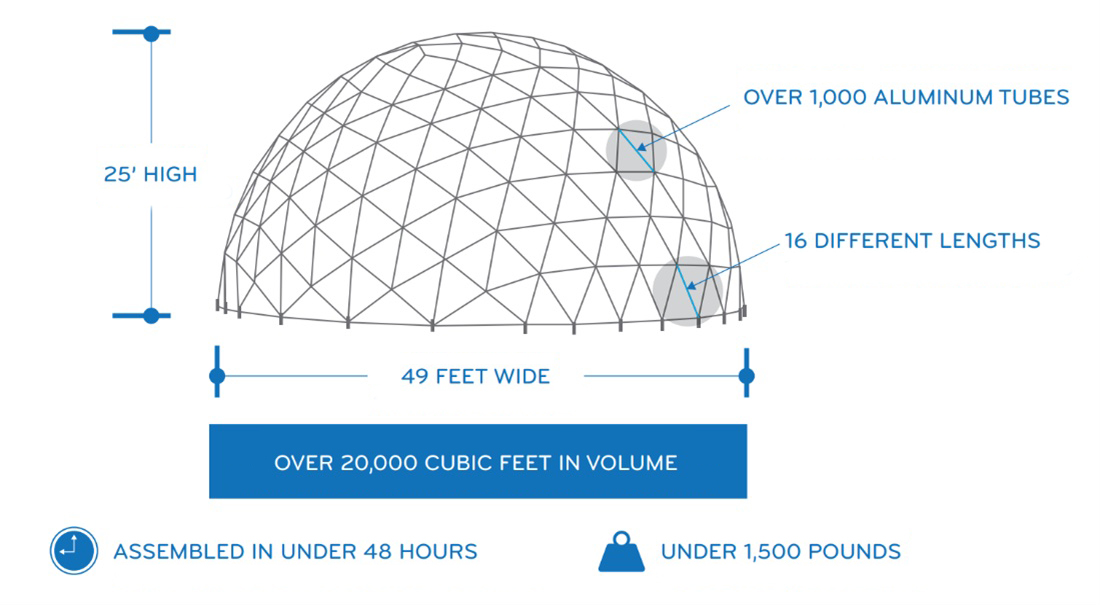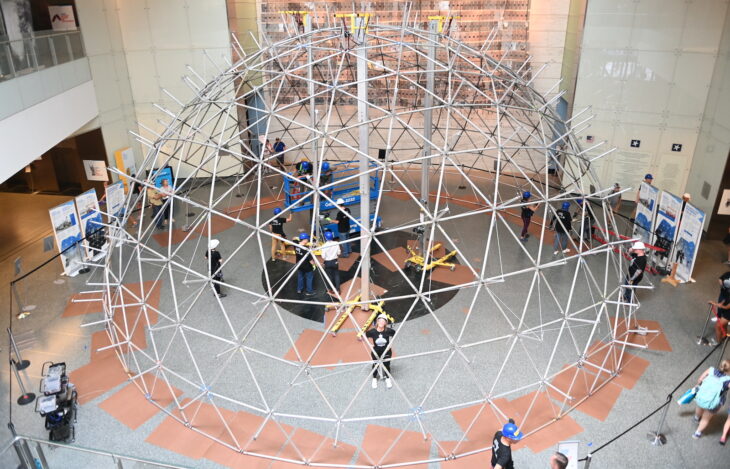Hydro partnered with the Catholic University of America (CUA) to reconstruct the iconic geodesic dome designed by famed architect, inventor, and futurist, Buckminster Fuller, inside the Smithsonian’s National Museum of American History. The dome is constructed with extruded aluminum structural members made from Hydro CIRCAL, the company’s certified aluminum product, which contains at least 75% recycled post-consumer scrap. The project is meant to show how these domes can be a viable solution for quick, affordable, and weather-resistant housing.
Brief History of the Geodesic Dome
Fuller’s original dome, known as Weatherbreak 8C270, was a large span, self-supporting geodesic dome. The structure was first constructed on the outskirts of Montreal, Quebec, in 1950. Jeffrey Lindsay, a former student of Fuller, and director of the Fuller Research Foundation’s Canadian Division, designed the innovative eight-frequency hemispherical icosahedron and oversaw all aspects of its manufacturing and installation. The reference to the eight frequency of a dome indicates how many times each of the sides of a triangulated base (face) is subdivided to create additional sections/struts. Those new points are then connected to divide the original triangle into smaller triangles. It is called a frequency because the same pattern is repeated throughout the entire dome structure.
The first recorded man-made geodesic dome, a globe-shaped planetarium made of interlocking triangles that reinforced each other was introduced by Walther Bauersfeld, a German engineer, in 1926. However, Fuller and Lindsay arguably perfected the design, which was an elegant and futuristic solution to many challenges of their era. The hardy properties of aluminum enabled the structural design to be lightweight, strong, and highly efficient. Fuller saw that the form’s reinforcing geometry brought hope as an inexpensive option for constructing hardy homes and other buildings. He improved the dome’s strength by drawing inspiration from natural structures including crystals and snowflakes. Besides the economic savings, the geodesic dome had a remarkable strength-to-weight ratio due to the use of aluminum in the design. This meant more parts could be transported easily and the structures could be built faster.
Reconstruction of the Weatherbreak
The original Weatherbreak dome, now part of the Smithsonian’s collection, consisted of nearly 1,000 pieces, many of which were damaged or lost over the course of time. Hydro helped to replace these lost pieces by providing extruded aluminum tubes that fit into the missing spaces. According to the company, the post-consumer Hydro CIRCAL offers the lowest carbon footprint of any aluminum products manufactured in the world today.
A student-led reconstruction of Weatherbreak (Figure 1) at the Smithsonian’s National Museum of American History began in early July and remained on exhibit through the end of the month. Under the guidance of associate dean of Graduate Studies, and assistant professor Tonya Ohnstad, CUA, lead fabricator Lorenzo Cardim DeAlmeida, and museum curator Abeer Saha, the student group explored the dome’s potential usage as affordable, resilient housing. Museum goers were able to watch the progress of its reconstruction in real time. After it was built, visitors were able to walk through the dome as part of the installation: Reconstructing Weatherbreak: Geodesic Domes in an Age of Extreme Weather.

“Thanks to Hydro, we can participate in the restoration of a truly historic piece of architectural history,” said Ohnstad, at CUA’s School of Architecture and Planning. “This project is a great learning experience for our students and the use of varied materials is an integrated part of their architecture education. We are looking forward to learning more about the benefits of aluminum as a sustainable building material through the partnership with Norsk Hydro.”
Hydro formed the recycled aluminum into the extruded profiles to be used in the structure at its extrusion facility in Elkhart, IN. “By increasing the use of post-consumer scrap and driving towards 100% recycled content, aluminum can play a vital role in decarbonizing the building industry,” said Charles Straface, president of Hydro Extrusion North America. “By taking end-of-life aluminum scrap and transforming it back into building components, we feel this project highlights the potential of aluminum to address climate change in unique ways.”
In addition to providing replacement pieces for the original structure, Hydro is supplying enough material for the CUA to construct a replica dome for a traveling exhibit in the future. If that structure ever reaches the end of its useful life, it will have an infinite future ahead of it.
Editor’s Note: This article first appeared in the August 2023 issue of Light Metal Age. To receive the current issue, please subscribe.

